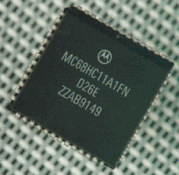
M68HC11
Until now all my work has been focused on the 8-bit M68HC11 and on the 32-bit 683xx microcontrollers produced by Motorola. Software development is done under Linux and sometimes MS-DOS. I'm using a variety of assemblers: Dasm by Matt Dillon (small and fast) or the as6811 by Alan Baldwin (rich macro assembler) for the 68hc11. Stephane Carrez's gcc-patch (for gcc-2.95.3 or gcc-3.0) is a very reliable and perfectly satisfying way to write code for the 68hc11 in the C programming language. Of course you can use the assembler of gcc, too, and have access to the complete toolchain of the gnu compiler collection: debugger gdb, newlib, etc...
The 68hc11 can be programmed in the
Java programming language designed by Sun Microsystems! Have a look at RTJ
Computing's SimpleRealTimeJava. It's worth it! You may want to
download a short reader concerned with the usage of Java on the 68hc11
(beware: written in German): J68HC11.pdf ! Also ready for free
download you get startup
code for simpleRTJ that has been tailored to be used with the
gcc-patch mentioned above. Just unpack besides the examples you can
download from Stephane's homepage (gnu-m68hc11.org). You need some header
files from his sample codes. The tarball also contains some examples from
me, some of which might be interesting to you: Among other things a simple
LCD-SPI interface utilizing a 595 shift register, in order to connect an
LC-display (with HD44780 controller) to a microprocessor with very few
wires. Everything has been tested thoroughly. Should you encounter any
problems: Please let me know. I'm thankful for your response. Or maybe you'll just like to
discuss something...
Moreover: a tiny EAGLE-library with among other components:
- MAX756 DC-DC converter
- M68HC11F1 microcontroller by Motorola (PLCC68 package)
- LCD with HD44780 controller (2x16 characters)
- TFDS4500 and TOIM3232 IrDA-interface from Vishay
- JStamp from Systronix with aJile's aJ-80

 webmasterLast
modified: Tue Oct 23 21:45:18 CET 2001
webmasterLast
modified: Tue Oct 23 21:45:18 CET 2001